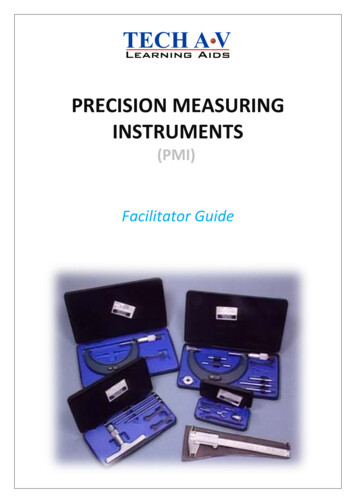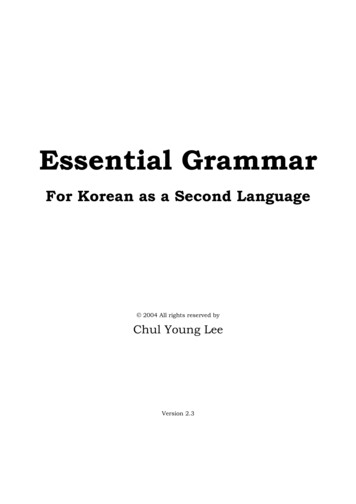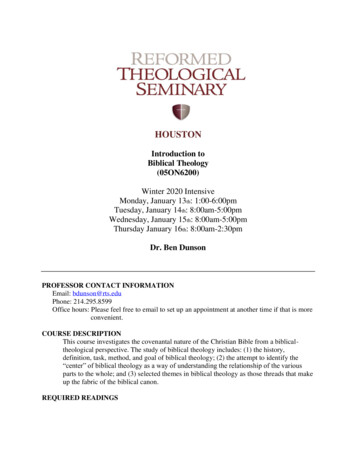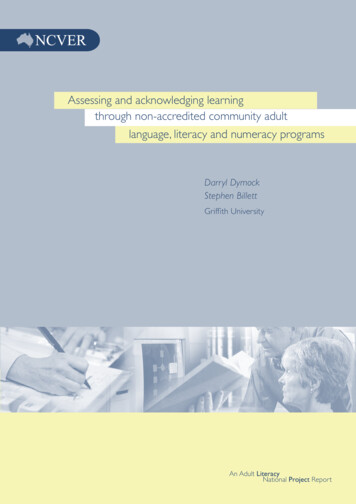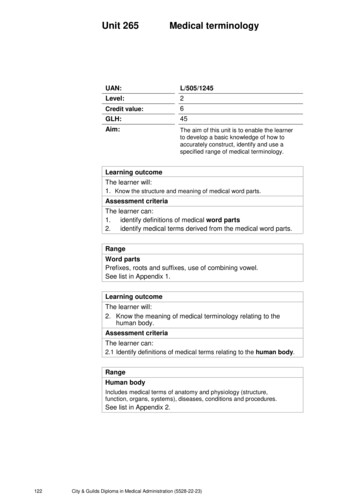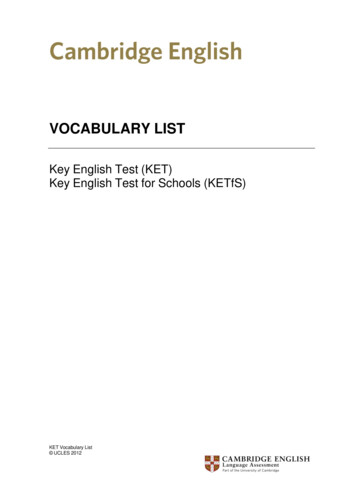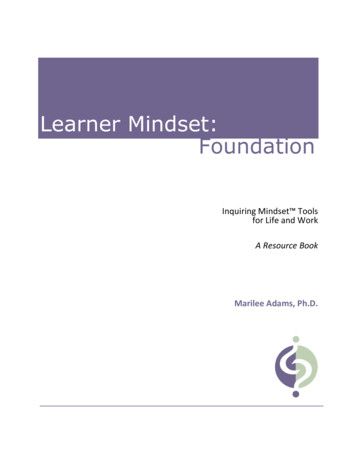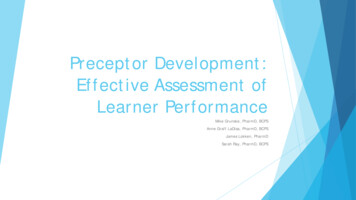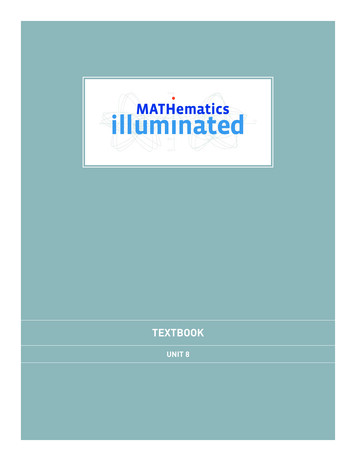
Transcription
TEXTBOOKUnit 8
UNIT 08Geometries Beyond EuclidTEXTBOOKUNIT OBJECTIVES Geometry is the mathematical study of space. Euclid’s postulates form the basis of the geometry we learn in high school. Euclid’s fifth postulate, also known as the parallel postulate, stood for overtwo thousand years before it was shown to be unnecessary in creating a selfconsistent geometry. There are three broad categories of geometry: flat (zero curvature), spherical(positive curvature), and hyperbolic (negative curvature). The geometry of a space goes hand in hand with how one defines the shortestdistance between two points in that space. Stereographic projection and other mappings allow us to visualize spaces thatmight be conceptually difficult. Einstein showed that curved geometry is a way to model gravitational attraction. The recently proven Geometrization Theorem states that if we live in a randomlyselected universe with a uniform geometry, then it is probably a hyperbolicuniverse.
It should be known that geometry enlightensthe intellect and sets one’s mind right. Allof its proofs are very clear and orderly. Itis hardly possible for errors to enter intogeometrical reasoning, because it is wellarranged and orderly. Thus, the mind thatconstantly applies itself to geometry is notlikely to fall into error. In this convenient way,the person who knows geometry acquiresintelligenceIbn Khaldun (1332-1406)
UNIT 8SECTIONINTRODUCTIONGeometries Beyond Euclidtextbook8.1Math encompasses far more than the study of numbers. At its heart, it isthe application of logic in the search for order in the world around us. Afundamental question in this search is how to divide up, or describe, space. Thestudy of this problem, geometry, has been of importance for thousands of years.The geometers of Ancient Egypt established geometric concepts and rules thatform the basis of a discussion that has continued into the modern age.The Egyptians were concerned with a variety of everyday geometric challenges,from how to divide up lands that had been flooded, to the construction of thepyramids. In fact, the need to measure and divide up land helped bring the word“geometry” into existence—“geo” meaning “earth,” and “meter” meaning “tomeasure.” The meanings of both of these roots have been expanded throughoutthe centuries so that now, the “earth” aspect can be thought of as encompassingall of space in general, and the “measure” element can be thought of as “divideinto regular sections.” Thus, a more useful, modern-day definition of geometryis “the study of how to break space up into regular sections.”As with other mathematical ideas, the geometric concepts of the Egyptians didnot stay confined to North Africa, but rather spread across the Mediterranean.Points, lines, circles, and planes formed the vocabulary of a new kind ofthinking, one that was tied to empirical observations, and yet could exist withoutthem. The Greeks latched onto this notion of conceptual mathematics, and sooncomplicated geometric ideas were being constructed with only the most basicof theoretical tools. Much of this knowledge, accumulated over centuries, wascollected and expanded upon by the great mathematician Euclid of Alexandriaaround 300 BC. His comprehensive collection of geometric knowledge, entitledThe Elements, went on to become the authoritative math book throughout theworld, with over a thousand editions since its initial printing in 1482.Of central importance to Euclid were his postulates. These were statementsthat could not be proven and had to be agreed upon as a starting point. His fivepostulates described a world of straight lines and flat planes. The shapes hefocused on were idealized versions of shapes found in nature. The geometricworld Euclid described was, and still is, a wondrous achievement of logicalconstruction. It is a world that behaves self-consistently, lending credence tothe idea that it is a model of the “real” world. This idea, that statements aboutthe real world can be made on the basis of reason alone, has guided much ofwestern thought for centuries.Unit 8 1
UNIT 8SECTIONINTRODUCTIONCONTINUEDGeometries Beyond Euclidtextbook8.1Euclid saw only part of the picture, however. Still, his geometry (which,throughout the remainder of this discussion, will be referred to as “Euclideangeometry”) withstood centuries of scrutiny by the best minds of the day. It wasnot until the 1800s that Euclid’s view of the world was shown to be inadequateas a model of the real world. The insights that have come to form the basis ofthe modern study of geometry do not conform to Euclid’s postulates—they do,however, lead to logical ways to describe the world as we know it, and spacein general. We are no longer challenged with questions of how to divide plotsof land; instead, our new tools enable us to ask, and answer, bigger questions.In fact, we can use the techniques of modern, non-Euclidean, geometry tounderstand the very fabric of reality.In this unit we will see how Euclid elegantly combined the mathematicalknowledge of his day into a logically self-consistent system. We will thenexamine how the close scrutiny of one of his fundamental assumptions led to anentirely new kind of geometric thinking. From there we will explore this modernview of geometry to see how one can replace Euclid’s straight lines with curvesand what that means for our understanding of the universe.Unit 8 2
UNIT 8SECTIONEuclideanGeometryGeometries Beyond Euclidtextbook8.2 Euclid of AlexandriaAxiomatic SystemsFoundations of GeometryEuclid of Alexandria Not much is known of Euclid’s life. Although he was not responsible for all of the content in The Elements,Euclid broke new ground in his organization of the foundationalmathematical knowledge of the day.Euclid is perhaps the most influential figure in the history of mathematics, so itis somewhat surprising that almost nothing is known about his life. The littlethat is known is mainly about his work as a teacher in Alexandria during thereign of Ptolemy I, which dates to around 300 BC. This was some while after thecreation of Euclid’s most famous work, The Elements.Euclid himself was known primarily for his skills as a teacher rather than forhis theorizing and contributions to research. Indeed, much of the content of thethirteen volumes that make up The Elements is not original, nor is it a completeoverview of the mathematics of Euclid’s time. Rather, this text was intendedto serve as an introduction to the mathematical concepts of the day. Its greattriumph was in presenting concepts in logical order, beginning with the mostbasic of assumptions and using them to build a series of propositions andconclusions of increasing complexity.Axiomatic Systems Axiomatic systems are a way of creating logical order. Axioms are agreed-upon first principles, which are then used to generateother statements, known as “theorems,” using logical principles. Systems can be internally consistent or not, depending on whether or nottheir axioms admit contradictions.The system that Euclid used in The Elements—beginning with the most basicassumptions and making only logically allowed steps in order to come up withpropositions or theorems—is what is known today as an axiomatic system. Hereis a very simple example of such a system:Unit 8 3
UNIT 8SECTIONEuclideanGeometryCONTINUEDGeometries Beyond Euclidtextbook8.2Given the things: squirrels, trees, and climbing,1. There are exactly three squirrels.2. Every squirrel climbs at least two trees.3. No tree is climbed by more than two squirrels.A logical theorem could be the statement: there must be more than two trees.A simple picture would prove this theorem:?123So, a theorem is something that can be shown to be true, given a set of basicassumptions and a series of logical steps with no contradictions introduced.Now, consider the following axiomatic system:Given the things: cat, dog1. A cat is not a dog.2. A cat is a dog.It is clear that both statements 1 and 2 cannot be true simultaneously. However,these are the basic axioms of our system, and axioms have to be assumedto be true—so, this system is clearly worthless, because it contains a logicalcontradiction from the start. In other words, it is not self-consistent. In thisexample, the contradiction presents itself directly in the axioms, but mostcontradictory systems are not so easy to identify.Unit 8 4
UNIT 8SECTIONEuclideanGeometryGeometries Beyond Euclidtextbook8.2Foundations of Geometry Euclid used five common notions and five postulates in The Elements. The fifth postulate, also known as the “parallel postulate,” is somehow notlike the others.CONTINUEDWhen Euclid laid the foundation for The Elements, he had to be careful to startwith statements that would be both self-consistent and basic enough to beassumed true. He divided his initial assumptions into five postulates1 and fivecommon notions. They are as follows:Common Notions:1. Things that are equal to the same thing are also equal to one another.2. If equals be added to equals, the wholes are equal.3. If equals be subtracted from equals, the remainders are equal.4. Things that coincide with one another are equal to one another.5. The whole is greater than the part.Postulates:1. Any two points can be joined by a straight line.2. Any straight line segment can be extended indefinitely in a straight line.3. Given any straight line segment, a circle can be drawn having the segmentas radius and one endpoint as center.4. All right angles are congruent.5. If two lines intersect a third in such a way that the sum of the inner angleson one side is less than two right angles, then the two lines inevitably mustintersect each other on that side if extended far enough.That fifth postulate is a mouthful; fortunately, it can be rephrased. In thefifth century, the philosopher Proclus re-stated Euclid’s fifth postulate in thefollowing form, which has become known as the parallel postulate:Exactly one line parallel to a given line can be drawn through any point not onthe given line.1 Note:A postulate is not quite the same as an axiom. Axioms are generalstatements that can apply to different contexts, whereas postulates areapplicable only in one context, geometry in this case.Unit 8 5
UNIT 8SECTIONEuclideanGeometryCONTINUEDGeometries Beyond Euclidtextbook8.2This postulate is somehow not like the other four. The first four seem to besimple and self-evident in that it seems things could be no other way, but thefifth is more complicated. Euclid, himself, likely noticed this discrepancy, ashe did not use the parallel postulate until the 29th proposition (theorem) of TheElements.Euclid’s system has been incredibly long-lasting, and it is still standard farein high school geometry classes to this day. It represents an achievement inorganization and logical thought that remains as relevant today as it was 2000years ago. That bothersome fifth postulate, however, showed a small crackin the foundation of the system. This crack was ignored for centuries untilmathematicians of the 1800s, with further exploration, found it to be a doorwayinto a world of broader understanding.Unit 8 6
UNIT 8SECTIONNon-EuclideanGeometryGeometries Beyond Euclidtextbook8.3 Of Questioned NecessitySaccheri’s QuadrilateralsOf Questioned Necessity There were multiple attempts to show that the parallel postulate was notnecessary to form an internally consistent geometry. Girolamo Saccheri built upon the work of Nasir Eddin in an attempt to “clearEuclid of every flaw.”Euclid’s parallel postulate bothered mathematicians for many years. Everyoneagreed that the first four postulates were completely obvious, but it seemedto be asking too much to say that the fifth was equally as obvious. It was morecomplicated than the other postulates, and, in fact, many thought that it couldactually be proved from them. This idea led to numerous attempts to show thatthe fifth postulate was not independent of the other four and that, therefore, allof geometry could be built upon only four fundamental ideas. One of the mostfamous of these attempts was undertaken by an Italian Jesuit named GirolamoSaccheri in the early eighteenth century.Saccheri wanted to show that the parallel postulate was not necessary (i.e., thatit was a derivative of the other four), and if the title of his book, “Euclid Clearedof Every Flaw,” is any indication, he truly believed that he had accomplished this.He, like many others before, believed that the parallel postulate could be provedfrom the other four. After numerous unsuccessful attempts to find a directproof of his claim, he tried a different tack. His renewed efforts were somewhatinfluenced by the work of one of Genghis Khan’s numerous grandchildren, NasirEddin. Eddin had attempted to prove the fifth postulate almost 500 years earlierby looking at quadrilaterals and making assumptions that he hoped would leadto contradictions. We’ve seen examples of similar “proofs by contradiction”before, such as Euclid’s proof of the infinitude of primes back in unit one.Unit 8 7
UNIT 8SECTIONNon-EuclideanGeometryCONTINUEDGeometries Beyond Euclidtextbook8.3Saccheri’s Quadrilaterals Saccheri looked at three cases of a quadrilateral constructed without the aidof the fifth postulate. Saccheri’s results, though intriguing, were misinterpreted.Saccheri’s approach was similar to that of Eddin. He began by considering aquadrilateral whose base angles are both 90 degrees:SUMMIT ANGLES1806BASE ANGLES START AT 90 He then showed that the summit angles must be equal to each other withoutusing the fifth postulate. In renouncing the parallel postulate in the constructionof this quadrilateral, Saccheri had to consider two possibilities—either:1. There are no lines parallel to a given line, or2. There are at least two lines parallel to a given lineThese cases presented three optional scenarios: 1) that the summit angles areacute, (which would allow for more than one p
TEXTBOOK. UniT OBJEcTiVEs Geometry is the mathematical study of space. Euclid’s postulates form the basis of the geometry we learn in high school. Euclid’s fifth postulate, also known as the parallel postulate, stood for over . two thousand years before it was shown to be unnecessary in creating a self-consistent geometry. There are three broad categories of geometry: flat .
